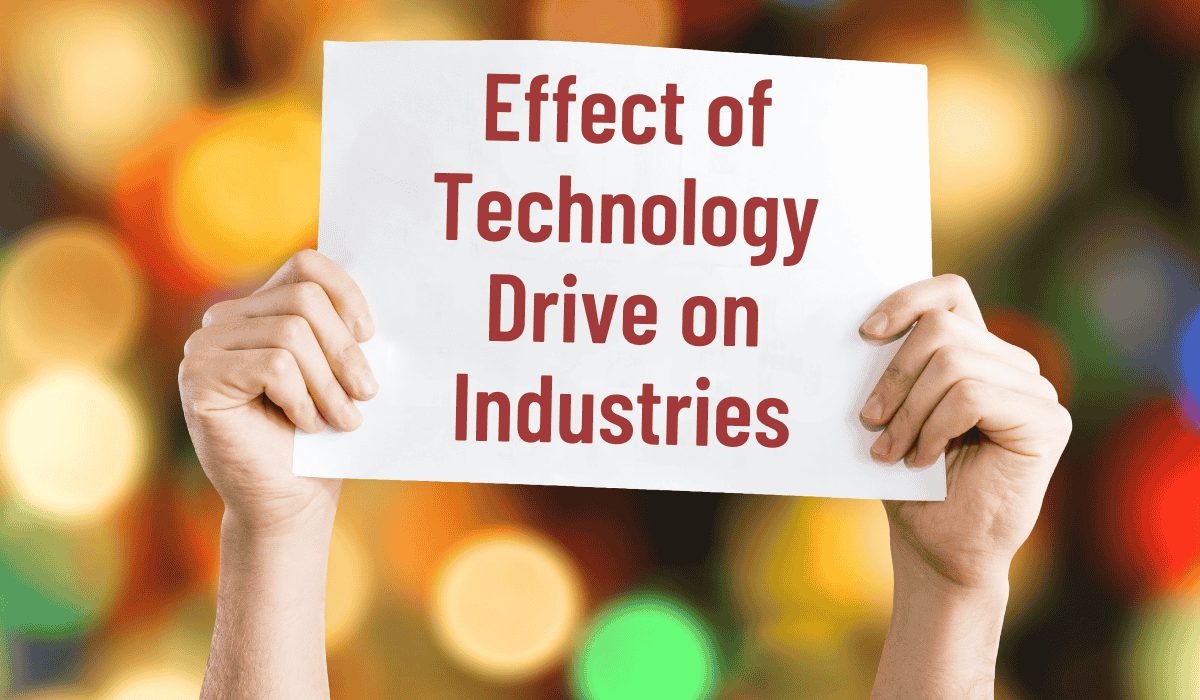Technology drive is very significantly shaping industries, businesses, and everyday life. From artificial intelligence to automation, the technology advancements are changing how people work, communicate, and solve problems. But what does technology drive mean? How does it impact different industries? And why is it important for growth? This article explores that and explains why adopting a technology-driven approach is essential in today’s world.
What is Technology Drive?
A technology drive is the fast-paced development and adoption of new technologies that alter industries, companies, and societies. It aims for innovation-driven progress, the creation of new opportunities, and increased efficiency to solve complex challenges. Instead of responding to the demands of the market, the approach of technology drive proactively molds industries by continuously improving things.
Characteristics of Technology Drive:
- Innovation-Driven Growth – Over and over, technology evolves in the economy and industries.
- Automation & Efficiency – AI, robotics & smart technologies work to optimize business operations by avoiding manual efforts
- New Business Models – Digital Transformation introduces new ways of revenue.
- Enhanced User Experience –AI, IoT and machine learning facilitate personalized customer interfaces
- Global Connectivity –Technology facilitates connectivity among users worldwide by developing better means of communication and collaborations
Technology drives are inevitable as they hold the success power in this era of the internet with regards to changing the direction of the future with the industry.
Effect of Technology Drive on Industries

Technology lies at the core of modern industrial progress, promoting efficiency, innovation, and growth in most industries. The technology drive has revolutionized industries in business, health, education, manufacturing, and digital marketing. Companies and individuals leveraging technology-driven solutions experience increased productivity, reduced costs, and enhanced decision-making.
Technology Drive in Business
Businesses in the present world operate on a technological approach while using automation, artificial intelligence, and cloud computing for efficiency, cost reduction, and winning in the highly dynamic market.
- Automation & AI: AI-powered chatbots and virtual assistants along with data analytics provide the rational way of running business and making decisions. AI improves the customer experience by providing real-time assistance, recommendations based on personalization, and predictive analytics to predict consumer behavior.
- Cloud Computing: As remote work is on the rise, the adoption of cloud computing has been increased. It allows teams to collaborate seamlessly from anywhere. Business benefits include lower infrastructure costs, better cybersecurity, and easier access to data. Cloud-based solutions also ensure business continuity by providing secure backups and disaster recovery options.
- E-commerce Growth: Technology drive changed the face of e-commerce where the AI-powered product recommendation makes customer experience very different, individualized marketing helps the business people reach their targets and seamless payments ensure that transaction takes place effectively. Digital Marketing is used here for search optimization, targeted advertising, and a campaign on various social media that can increase its visibility and online sales.
Thus, productivity and customer involvement improve, so does the company’s competitive power in the electronic economy.
Also read: What is Deep Offshore Technology and How Is It Shaping the Future of Energy?
Technology Drive in Healthcare
Healthcare is embracing more technology in patient care, diagnostics, and operations.
- Telemedicine: Virtual consultations provide an opportunity for a patient to receive medical advice from home, increasing accessibility in most areas. This reduces hospital overcrowding and provides timely medical attention.
- AI Diagnostics: Machine learning algorithms analyze the medical data of patients to predict diseases with high accuracy. Through AI-driven diagnostics, doctors get quicker and more accurate decisions so that the early detection of the disease is guaranteed, and effective treatment is facilitated.
- Wearable Tech: Advanced health-related fitness trackers and smartwatches monitor the real-time metrics on a person’s health, such as heart rate, oxygen levels, and sleep patterns. In this regard, wearable tech promotes preventive healthcare by providing smarter alerts on several health risks and healthy lifestyle habits.
The technology drive in healthcare services is making it efficient, accessible, and patient-centric.
Technology Drive in Education
Education has become more appealing and engaging by utilizing the technological aspect in learning: the environment around a learner’s study, so all learners globally benefit.
- The emerging E-learning platforms of Coursera, Udemy, and Khan Academy allow breaking geographical boundaries for quality education by every learner. The online learning platform has proven to be flexible, self-paced, with no restrictions – that is why access to a student is now at any point from anywhere.
- AI Tutors: AI guided learning systems can provide lessons with a different pace of learning for each student and can also offer immediate feedback. Intelligent systems do better in comprehending and remembering because learning becomes more effective.
- VR Classrooms: Virtual reality enables the students to participate in learning experiences such as historical reenactment and science experiments, or even just applying theoretical knowledge through simulations mimicked by the real world.
A technology-driven education system will allow both students and instructors to enjoy innovations that enhance the learning experience and improve accessibility in bridging the gaps of educational inequality.
Technology Drive in Manufacturing
The manufacturing industry has incorporated a technology drive by using automation, robotics, and artificial intelligence (AI) to make efficiency, precision, and cost-effectiveness.
- Robotics & Automation: AI-Powered Robots. AI has improved, and hence the work done by robots becomes redundant, while the human mistake reduces. Productivity in the company increases with a guarantee of quality products and minimal labor costs.
- 3D Printing: Additive manufacturing or 3D printing accelerates prototyping. Business can come up with a product and test it easily. It reduces waste, lowers the production cost, and encourages creativity in design.
- IoT in Supply Chains: The Internet of Things (IoT) and smart sensors improve the inventory management, logistics, and goods movement tracking in real time. This would ensure on-time delivery and reduce the operational risk of the operation of supply chains.
A technologically driven manufacturing sector enables higher productivity, improved innovation in products, and, therefore, enhanced competitiveness worldwide.
Technology Drive in Digital Marketing
The digital marketing scenario has undergone a change with technological strategies that allow businesses to reach their target audience much more efficiently.
- AI & Data Analytics: AI analyzes consumer behavior, and businesses can thus create highly personalized marketing campaigns. Predictive analytics helps brands anticipate trends, customer preferences, and buying patterns, thereby improving decision-making.
- Automation in advertising: How programmatics advertising uses automation to place ads automatically for maximum performance with low cost. AI-generated content like automated email response and chatbots enhance engagement and interaction with the customer by automating certain tasks.
- SEO & Voice Search: AI-driven SEO strategy refines the placements of the website by analyzing search trends and optimizing content to match the trend. With voice assistants like Alexa and Google Assistant, voice search optimization keeps businesses on top in the spoken queries.
- Social Media Innovations: AI chatbots are delivering real-time customer support, influencer marketing and advanced targeting, and helping the brands reach the audience in the best possible manner.
With the technology-driven approach, digital marketing is continuously developing and offering smart, data-driven solutions to the businesses for getting more visibility, engagement, and conversion.
Why Businesses Should Take a Technology-Driven Approach
In today’s fast-paced digital world, the need of the hour for businesses to be competitive, efficient, and innovative is a technology-driven approach.
- Competitive Advantage: Companies that integrate technology improve efficiency, decision-making, and innovation, gaining an edge over competitors.
- Enhanced Productivity: Automation tools and AI-powered systems reduce manual workload, enabling employees to focus on strategic growth and complex problem-solving.
- It saves costs. Technology automates functions, optimizes resource use, and reduces waste, which means a huge cost saving.
- Experience in the Purchase: AI-based chatbots, customization recommendation, and frictionless digital purchases enhance the experience of customers, thereby increasing loyalty and retention.
- Scaling: A technology-based model makes it easier to scale quickly. This allows companies to keep pace with shifting market dynamics and change the needs of customers.
With technology-driven solutions, businesses can be more efficient, profitable, and relevant in an ever-changing digital landscape.
Role of Marketing in Technology
Marketing plays a critical role in pushing technology-based innovation to market. It acts as the interface between the technological breakthrough and consumer needs so that the businesses are able to convey their value propositions properly.
- Education for the Consumers: Marketing simplifies complex technology so that the audience can understand and be accessed with content marketing, explainer videos, and tutorials.
- Building Brand Awareness: SEO, social media, and paid ads can create wider visibility for technologically advanced products and services.
- Drive Sales and Lead Generation: Targeted campaign activities, analytics based on artificial intelligence, and customized marketing work well in conversion of prospects to customers.
- Enriching the Engagement with Customer: Interactive instruments such as a chatbot, webinar, or recommendations through artificial intelligence will work on user engagement and develop more connections with them.
- Market Adaptation & Innovation: Data-based information allows technology-driven companies to adapt their offers according to evolving market requirements.
The right strategies for marketing, the right market reach, improvement in customer confidence, and more growth will emerge with the maximum use of reach for technology-driven businesses.
Future of Technology Drive
In an increasingly digital world, technology drive will keep leading the change for industries and society. The next near future includes the following emerging trends:
- Artificial Intelligence & Machine Learning: AI will further refine automation, decision-making, and predictive analytics.
- Blockchain Technology: Secure transactions, decentralized systems, and blockchain will revolutionize industries.
- 5G Connectivity: Fast internet speeds will enable advanced applications and seamless communication.
- Sustainable Tech: Green innovations will focus on coming back to eco-friendly solutions and energy efficiency.
Conclusion
A technology drive is important for progression, efficiency, and innovation. It brings about improvements in productivity, savings, and customer experience, from business and health care to education and manufacturing. As the trend of technological changes continues to progress, it is only a matter of embracing change to keep abreast with this increasingly digital world.
With the understanding and embracing of a technology-driven approach, businesses and individuals will be able to face the future with confidence, unlocking limitless possibilities.
FAQ’s
What does a technology-driven approach mean in business?
It means using automation, AI, cloud computing, and data analytics in such a way as to enhance efficiency while cutting costs and enhancing decision-making.
How does technology drive impact digital marketing?
Technology advances digital marketing through AI analytics, automation, SEO, programmatic advertising, and social media innovations, making it possible for businesses to reach their audience.
Why is technology important in healthcare?
Technology advances healthcare through telemedicine, AI diagnostics, and wearable health devices, which make patient care more efficient, increase early disease detection, and gain easy access.
How does technology advance the manufacturing industry?
In manufacturing, technology also increases efficiency through such factors as automated robotics, the Internet of Things, and 3D printing that brings about fewer errors, the more streamlined supply chain network, and faster production.
How does marketing influence tech adoption?
This gap from technology to consumer is bridged in this case by marketing through the education of consumers, creating more awareness of a brand, promoting sales, and enhancing the involvement of customers through targeted digital strategies.

